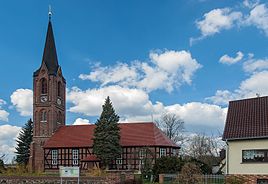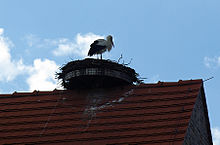Dissen (Dissen-Striesow)
|
Dissen
Dešno Dissen-Striesow municipality
Coordinates: 51 ° 49 ′ 34 ″ N , 14 ° 17 ′ 21 ″ E
|
|
|---|---|
| Height : | 60 m above sea level NHN |
| Area : | 13.06 km² |
| Residents : | 671 (Dec 31, 2006) |
| Population density : | 51 inhabitants / km² |
| Incorporation : | December 31, 2001 |
| Postal code : | 03096 |
| Area code : | 035606 |
|
Dissen village church
|
|
Dissen , Dešno in Lower Sorbian , is a district of the municipality of Dissen-Striesow in the Spree-Neisse district in Brandenburg . The place belongs to the Burg (Spreewald) office and was an independent municipality until December 31, 2001.
location
Dissen is located in Lower Lusatia, about ten kilometers northwest of Cottbus and is part of the official settlement area of the Sorbs / Wends . Surrounding villages are Drachhausen in the north, the Cottbus neighborhoods Maiberg in the Northeast, Döbbrick East and Döbbrick the east, Skadow the southeast and Sielow in the south of the municipality Kolkwitz belonging district Gulben in the southwest, Briesen and STRIESOW the west and Fehrow in the northwest.
State road 511 runs through Dissen from Cottbus to Strießow. The Spree flows north of the village , and several moats also flow through the village.
To Dissen which includes residential space Old sheepfold (Stara šaparnja) as well as the unofficial parts of the village Grabow , Kněski Dvor , Konč , Pśedejs and We jsy .
history
Dissen was founded by West Slavic settlers from the Lusitzi tribe . The place was first mentioned in 1449 in a document as part of the Mark Brandenburg . In 1464 the place was already listed as Dissen . In the following time the place name changed from Dissow (1466) to Dessen (1486), Dossenn (1502) and Dysenn (1543) back to Dissen in 1652. After that, the place was listed three times under a different name, 1761 as Deschno , in 1843 under his Sorbian name Dešno and again as Deschno in 1847. The place name is probably derived from the Sorbian personal name Dycha and means village of Dycha . Another possible meaning is dull smelly place , which indicates the location of the place.
The Wendish village church of Dissen was built in 1772. In 1937 it was designed with verses from the Bible in Lower Sorbian . Services in the Sorbian / Wendish language were held in the church until the 20th century, until this was forbidden by the National Socialists ; Bogumił Šwjela held the last Sorbian service before this ban in 1941. Wendish services have been held in the village church again since 1987.
Since 1978 there has been a local museum in Dissen , which shows the life of the former Wendish and rural population. Among other things, tools, household items and children's toys as well as various variants of Sorbian costumes are exhibited there .
With eight to twelve occupied stork nests a year, Dissen is one of the most stork-rich villages in Germany.
In 2005 Dissen was the winner of the Spree-Neisse district in the competition Our village has a future .
After the Congress of Vienna , Dissen came to the Kingdom of Prussia as part of Niederlausitz . On July 25, 1952, the community was added to the newly formed Cottbus-Land district in the Cottbus district. After the reunification , Dissen was in the Cottbus district in Brandenburg and has been part of the Burg (Spreewald) office since July 16, 1992 . After the district reform in Brandenburg on December 6, 1993 , Dissen finally came to the newly formed Spree-Neisse district . On December 31, 2001, Dissen was merged with the neighboring town of Striesow to form the new municipality of Dissen-Striesow .
Sorbian language
Until the 1950s , Sorbian / Wendish was the colloquial language in town. For his statistics on the Sorbian population in Lusatia, Arnošt Muka determined a population of 815 inhabitants, all of whom were Sorbs , in the 1880s . In 1956, Ernst Tschernik still had a Sorbian-speaking population of 74.8%. Since then, the proportion of the Sorbian-speaking population has declined; in 1995, 28.9% of the population still knew Sorbian. In 2003, Dissen was recognized as a language-friendly municipality in a state competition . Furthermore, the children in Dissen learn the language as part of the Witaj project in kindergarten .
In Dissen, as in almost all places in the Sorbian settlement area, the place and street signs are bilingual. The monolingual Sorbian district boards are a special feature.
Population development
| Population development in Dissen from 1875 to 2000 | |||||||||||||
|---|---|---|---|---|---|---|---|---|---|---|---|---|---|
| year | Residents | year | Residents | year | Residents | ||||||||
| 1875 | 757 | 1939 | 658 | 1981 | 536 | ||||||||
| 1890 | 778 | 1946 | 781 | 1985 | 525 | ||||||||
| 1910 | 688 | 1950 | 690 | 1989 | 498 | ||||||||
| 1925 | 697 | 1964 | 646 | 1995 | 522 | ||||||||
| 1933 | 678 | 1971 | 586 | 2000 | 659 | ||||||||
Others
The district of Dissen has had partnerships with the Lower Saxony city of Dissen in the Teutoburg Forest and the district of Dissen in the Hessian city of Gudensberg since reunification . These partnerships continued after the church was dissolved on December 31, 2001.
Personalities
- Měto Bukwaŕ (Martin Buckwar; 1789–1843), pastor in Dissen since 1830 and also died there
- Bogumił Šwjela (Gotthold Schwela; 1873–1948), Sorbian clergyman and linguist, pastor in Dissen for 28 years
- Trixi Worrack (* 1981), professional cyclist, lives in Dissen
Web links
- Dissen on the website of the municipality of Dissen-Striesow
- Dissolved in the RBB program Landschleicher on May 29, 2005
proof
- ↑ Community and district directory. In: geobasis-bb.de. Land surveying and geographic base information Brandenburg, accessed on June 20, 2017 .
- ↑ a b c d e Dissen / Dešno-A Wendish village on the Spree. In: dissen-striesow.de. Dissen-Striesow, accessed on May 28, 2017 .
- ^ Hanswilhelm Haefs: Place names and local stories from the Spreewald . 2014, ISBN 978-3-7357-3556-0 , pp. 93 ( limited preview in Google Book search).
- ^ Dissen Local History Museum. In: dissen-striesow.de. Dissen-Striesow, accessed on May 28, 2017 .
- ^ Dissen in the historical index of places. Retrieved May 28, 2017 .
- ↑ Ernst Tschernik: The development of the Sorbian population . Akademie-Verlag, Berlin 1954.
- ^ Ludwig Elle: Language policy in the Lausitz . Domowina-Verlag, Bautzen 1995.
- ↑ Historical municipality register of the state of Brandenburg 1875 to 2005. (PDF; 331 kB) District Spree-Neisse. State Office for Data Processing and Statistics State of Brandenburg, December 2006, accessed on May 28, 2017 .
- ↑ Partnerships are like friendships. Neue Osnabrücker Zeitung , August 3, 2004, accessed on August 11, 2019.
- ↑ District partnerships . Community of Gudensberg, accessed on August 11, 2019.


